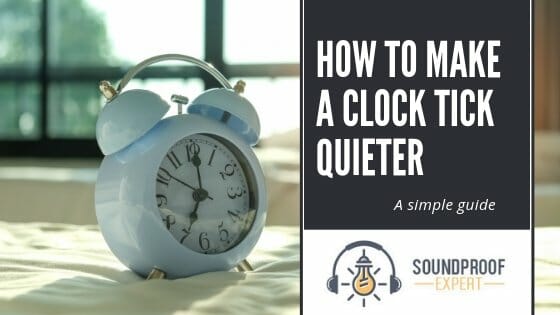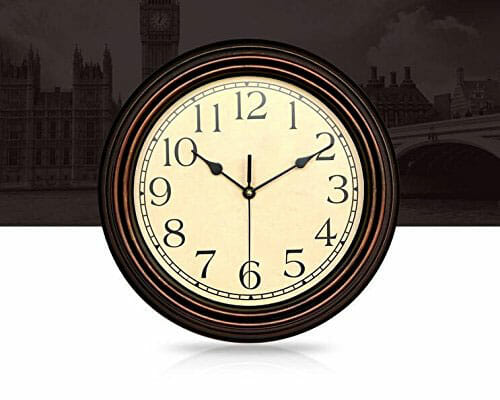
Sometimes you just need a little peace and quiet and if you have a wall or desk clock that keeps ticking away, that might tick you off. While there are certainly many clocks out there that are non-ticking, yours may not be in that category. Thankfully, there’s something you can do by learning how to make a clock tick quieter.
So, how do you make a clock tick quieter?
Making a clock tick quieter requires you to either cover it with a solid object to absorb the noise or to take the clock apart to oil the gears and insert foam padding. However, the best solution to make a clock quieter is to purchase a non-ticking clock.
There are times when I enjoy having a ticking clock in my house because it can bring a sense of homeliness and comfort.
However, there are times when I need to concentrate and it’s extremely difficult to do so with a continuous “tick-tock” going on in the background. That’s exactly why I laid out a simple guide for you on how to make a clock tick quieter.
How to Make a Clock Tick Quieter
There are a lot of different types of clocks out there, including wall clocks, alarm clocks, pendulum clocks, and even that little clock on your wrist.
While there’s certainly room for discussion for quieting all of these types of clocks, we’ll be focusing mainly on wall clocks and alarm clocks, since they’re the most common clocks found in our homes.
There are some simple ways to approach quieting your clock’s tick, which include:
- Covering your clock with a sound-insulating material.
- Opening up your clock followed by oiling the gears and inserting foam.
- Simply purchasing a new, non-ticking clock.
Depending on your situation, you may choose one option over the other. Thankfully, there are enough choices for any loud clock owner to find a way to silence their clock once and for all.
By far the easiest and most simple approach to making a clock tick quieter is by covering it with a sound-insulating material.
As you might expect, you may want to decide whether that material is transparent or not, depending on whether you still need to tell the time during your moments of silence.
One of the best transparent materials that are effective at insulating sound is glass.
Glass is effective at insulating sound because it’s a very acoustically reflective material, which means the sound has a difficult time traveling through it compared to other materials such as wood. However, the best type of glass to get to make a clock tick quieter is laminated glass, as opposed to tempered glass, since it has better sound reflective qualities.
If you don’t care about being able to read the time during your times of silence, your best bet is to get yourself some acoustic foam.
By creating a little box out of acoustic foam, you’ll be able to effectively remove the sound coming from your clock without any hassle.
The Auralex Acoustics Studiofoam Wedgies Acoustic Absorption Foam (link to read reviews on Amazon) is a great choice and are commonly used in sound studios by musicians all over the world.
Depending on your needs, you may want to simply take your ticking clock apart and figure out a way to change it from inside. Making a clock tick quieter is easier when you simply cover it, but getting inside of it and figuring out how it works is also fun. It can also lead to a quieter clock, which is the whole point.
A simple way to quiet a clock is to open it up carefully, oil all of its gears and internal parts, and stuff it wherever possible with acoustic foam. This is by far the best approach to take if you don’t want to cover up your clock, but it won’t be 100% silent when you’re finished.
When opening up your clock and lubricating the internals, you want to wait around 15 minutes before inserting any sound-absorbing foam. If you go this route a simple material, like egg crate acoustic foam (link to read reviews on Amazon), is highly effective and doesn’t break the bank. I’ve used this exact material plenty of times and it’s always worked out well for me.
If you’re not looking to cover your clock with transparent or non-transparent material or even take apart your clock and fix it up internally, you’ll pretty much have no other choice but to get a new clock.
There are so many clocks out there nowadays that are non-ticking that you won’t have a shortage of options.
On top of that, this is by far the easiest option to go with, unless your clock has some sentimental value or otherwise.
How to make a clock tick quieter is, as you can see, much easier than you might have thought.
By following one of these three simple strategies, you’ll have a quieter clock in no time resulting in a more peaceful, calm environment.
But don’t take my word for it! Try them out for yourself and see if they work for you. I bet one of them will.
Why Do Clocks Tick?

Back in the day, someone must have thought to themselves: “I’m going to make these clocks produce a noise.” Well, I’m guessing it didn’t go that exact way, but it seems strange that clocks are known for making that all-to-familiar “tick-tock” sound. Funny enough, even some digital clocks tick, which is interesting since they have no reason to.
Clocks tick due to the mechanical construction they have internally. It all started with the pendulum clock a very long time ago and has carried over to mechanical and electrical clocks today.
Whether you have a standing clock, wall clock, or a wristwatch, you’ve probably experienced this tick-tocking.
The main reasons pendulums tick is because for every swing the clock’s second-hand moves one position forward.
There’s an internal gear called the escapement gear that gets set and reset every time the clock goes from tick to tock, resulting in the second hand moving forward and causing the sound “tick-tock.”
More modern clocks that are either mechanical or electric also produce a sound for similar reasons. The gears and internal workings of the clocks are moving the second hand forward (even if the second hand is actually only internal), which results in this ticking sound.
Of course, there are many clocks nowadays that don’t produce this ticking sound due to more continuous movements in the gears, but you’ll still hear these designs at work.
More modern clocks don’t necessarily tick, but it’s become so commonplace to expect that “tick-tock” sound that it’s almost nostalgic.
That’s why even some digital clocks have the ability to produce this sound, even though it’s completely artificial.
That just goes to show the desire for the sound, but it’s certainly nice to be able to make a clock quieter when necessary.
Best Quiet Clocks to Choose From
If you’re on the hunt for a non-ticking clock, there are a lot of fantastic choices out there that’ll fit any situation or decor. Whether you’re in need of a wall clock or a simple alarm clock, you definitely want to take a look at the following products.
Bekith 12-Inch Round Classic Retro Non-Ticking Decorative Wall Clock

Choosing to purchase a non-ticking wall clock means it should be quiet but also somewhat stylish. That’s why I’m a huge fan of the Bekith 12-Inch Round Classic Retro Non-Ticking Decorative Wall Clock (link to read reviews on Amazon). It not only looks great, but it serves the proper function of being quiet all the time.
This is a great non-ticking wall clock by Bekith because it does exactly what you want it to do; be quiet.
It’s powered by a single AA battery and lasts a very long time. The stylish retro look also fits perfectly in almost any setting, so you can easily hang it wherever you want. Not only that, but it’s also very affordable!
Peakeep Ultra Small No Ticking Analog Quartz Alarm Clock

No one needs a ticking sound coming straight into their ears while they’re trying to get some shut-eye.
If you’re looking for a high-quality alarm clock, take a look at the Peakeep Ultra Small No Ticking Analog Quartz Alarm Clock (link to read reviews on Amazon). It’s compact and easy to use for anyone looking for a non-ticking alarm clock.
My favorite part about this alarm clock, apart from it being quiet, is that it has an obvious button that silences it when it starts buzzing. I don’t know about you, but being able to easily shut off the alarm in the morning is key to having a good start to my day.
It also has an illuminated clock face, so you can figure out the time without effort and even find where your nightstand is when coming back from the bathroom in the middle of the night.

There are times where I used to appreciate my clock ticking quite loudly, but now, I can’t stand its noise. Thanks for the idea that I can put it on a box made out of acoustic foam to try to get rid of the noise. If that doesn’t work, I think I’ll take it to a repair shop to have it modified.
Would the author have any specific suggestions (or perhaps a link, for a how-to video?) regarding how to make a never before used alarm clock (it is a new old stock alarm clock that I recently purchased from Japan, Seiko model QN401) not tick the seconds by quite so loudly?
I don’t sleep so well beside it, the way it is right now, but it sure keeps great time, and the alarm is a breeze to operate, plus it’s a very cool papaya orange color. I love the flipping tiles, the intermittent softly flapping sound they make is great! It’s just that sound of the seconds tick tocking away like a little gizmo motor that disturbs my sleep (making me crazy).
Great article! I hope I can get some specific pointers for my clock, thanks!